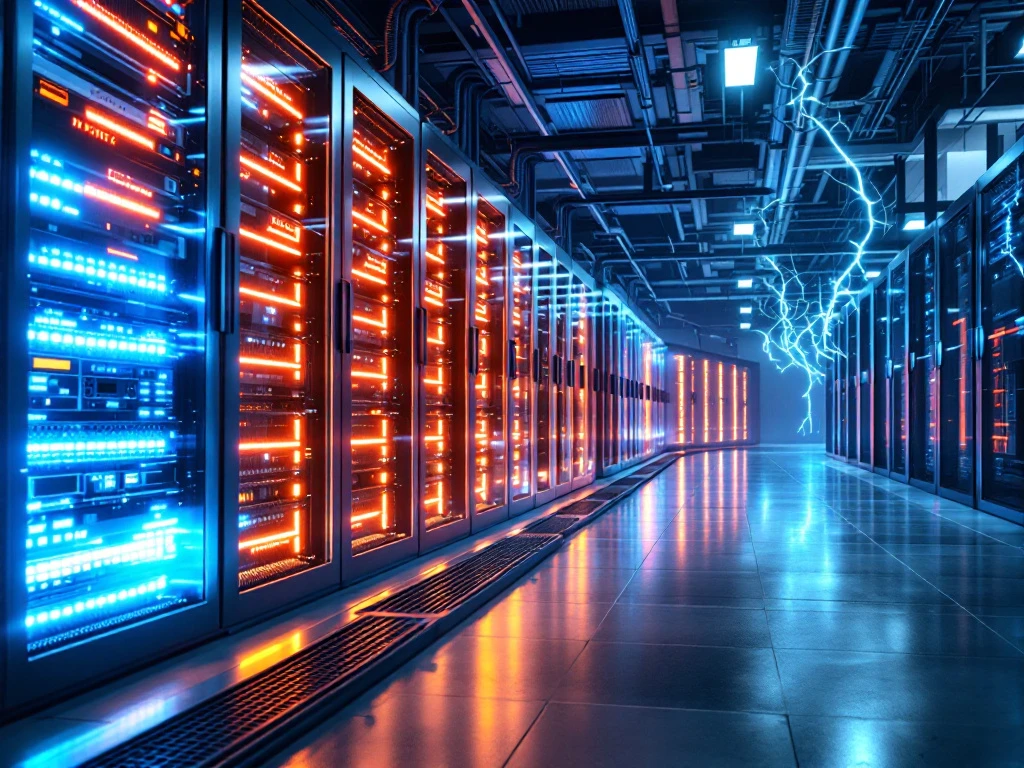
Datacenter services ensure reliable power supply through multiple redundant systems, uninterruptible power supplies (UPS), backup generators, and continuous monitoring by certified technicians. These layered protection systems prevent single points of failure and maintain consistent power delivery even during utility outages or equipment maintenance. Professional power infrastructure management is essential for preventing costly downtime and protecting critical business operations.
What makes datacenter power supply systems so critical for business operations?
Power supply systems form the foundation of all datacenter operations because every piece of equipment depends on consistent electrical delivery to function properly. Modern businesses rely entirely on their digital infrastructure, making power interruptions catastrophic for operations, data integrity, and financial performance.
The cascading effects of power failures extend far beyond simple equipment shutdowns. When datacenter services experience power disruptions, businesses face immediate revenue losses, corrupted data, damaged hardware, and compromised customer trust. Critical applications stop responding, transactions fail to process, and recovery efforts can take hours or days depending on the severity of the interruption.
Business continuity depends on power reliability because modern operations cannot function without consistent electrical supply. Even brief power fluctuations can cause server crashes, network outages, and storage system failures that impact everything from customer transactions to internal communications. The financial impact grows exponentially with downtime duration, making reliable power infrastructure a fundamental business requirement rather than a technical preference.
How do datacenter services implement redundant power systems?
Datacenter services implement redundant power systems through multiple configuration strategies including N+1, 2N, and 2N+1 architectures that eliminate single points of failure. These systems combine multiple utility feeds, backup generators, and distributed power architecture to ensure continuous availability even during equipment maintenance or component failures.
N+1 redundancy provides one additional power component beyond minimum requirements, meaning if you need four power units, you install five. The 2N configuration doubles all power infrastructure, creating completely separate power paths from utility connection to equipment. 2N+1 combines both approaches, providing double infrastructure plus additional backup capacity for maximum protection.
Multiple utility feeds connect datacenters to different electrical grids, preventing outages from affecting all power sources simultaneously. Backup generators automatically activate when utility power fails, whilst distributed power architecture spreads electrical loads across multiple systems to prevent overloading any single component.
These redundant systems work together seamlessly through automatic transfer switches that detect power issues and redirect electrical flow within milliseconds. This layered approach ensures that equipment continues operating normally even when primary power sources fail or require maintenance.
What role do UPS systems play in datacenter power reliability?
UPS (Uninterruptible Power Supply) systems provide immediate backup power during utility outages and bridge the critical gap between power loss and generator startup. These systems deliver clean, consistent power whilst protecting sensitive equipment from voltage fluctuations, surges, and brief interruptions that could damage hardware or corrupt data.
Three main UPS types serve different datacenter needs. Online UPS systems continuously power equipment through battery backup, providing the highest protection level. Line-interactive UPS units regulate voltage automatically and switch to battery during outages. Standby UPS systems monitor power quality and activate battery backup when problems occur.
Battery technologies within UPS systems include sealed lead-acid, lithium-ion, and nickel-cadmium options, each offering different runtime capabilities and maintenance requirements. Runtime calculations depend on connected equipment power consumption and battery capacity, typically providing 5-15 minutes of backup power for generator startup.
UPS integration with other power infrastructure creates seamless protection layers. When utility power fails, UPS systems instantly provide backup power whilst sending signals to start backup generators. This coordination ensures continuous power delivery throughout the transition period, preventing any interruption to critical operations.
How do professional technicians monitor and maintain datacenter power infrastructure?
Professional technicians monitor datacenter power infrastructure through advanced monitoring systems that track electrical loads, temperature conditions, battery health, and generator status in real-time. These certified specialists perform predictive maintenance, thermal management, and load balancing to prevent failures before they impact operations.
Proactive monitoring systems continuously measure power quality, voltage levels, current draw, and environmental conditions across all infrastructure components. These systems generate alerts when parameters exceed normal ranges, enabling technicians to address issues before they cause outages. Remote monitoring capabilities allow 24/7 oversight even when technicians are not physically present.
Predictive maintenance strategies include regular battery testing, generator exercise routines, electrical connection inspections, and cooling system maintenance. Thermal management ensures optimal operating temperatures for all power equipment, whilst load balancing distributes electrical demands evenly across available capacity to prevent overloading.
The importance of certified onsite technicians cannot be overstated for maintaining power system reliability. These professionals understand complex electrical systems, safety protocols, and emergency response procedures essential for preventing costly failures. Our comprehensive datacenter services include expert field engineering support that maintains power infrastructure reliability through skilled professional oversight, ensuring your critical operations continue without interruption.
Frequently Asked Questions
How long does it typically take for backup generators to start when utility power fails?
Most modern datacenter backup generators start within 10-15 seconds of detecting utility power failure. However, UPS systems provide immediate power during this brief transition period, ensuring zero interruption to critical operations. Generator startup time depends on engine type, fuel system, and maintenance condition.
What are the warning signs that a datacenter's power infrastructure needs immediate attention?
Key warning signs include frequent UPS battery alarms, voltage fluctuations, unusual generator behavior during testing, overheating power equipment, and increasing electrical load imbalances. Any recurring power quality issues or equipment that fails routine maintenance checks should trigger immediate professional assessment to prevent catastrophic failures.
How often should UPS batteries be replaced in a datacenter environment?
UPS batteries typically require replacement every 3-5 years depending on usage patterns, environmental conditions, and battery technology. Sealed lead-acid batteries may need replacement sooner in high-temperature environments, while lithium-ion batteries can last 8-10 years. Regular capacity testing helps determine optimal replacement timing before performance degrades.
Can businesses test their datacenter power systems without risking downtime?
Yes, professional technicians can perform comprehensive power system testing using planned maintenance windows and staged testing procedures. This includes generator load testing, UPS transfer testing, and redundancy verification while maintaining full operational capacity through redundant systems. Proper testing schedules ensure system reliability without operational disruption.
What's the difference between power redundancy levels, and which one do most businesses need?
N+1 provides basic redundancy suitable for most small-to-medium businesses, while 2N offers complete system duplication for mission-critical operations like financial services or healthcare. 2N+1 provides maximum protection for enterprises that cannot tolerate any downtime. Most businesses find N+1 redundancy adequate, but high-availability requirements may justify 2N investment.
How do environmental factors affect datacenter power system performance?
Temperature, humidity, and altitude significantly impact power system efficiency and lifespan. High temperatures reduce UPS battery life and generator performance, while excessive humidity can cause electrical component corrosion. Proper HVAC systems and environmental monitoring are essential for maintaining optimal power infrastructure performance and preventing premature equipment failure.
What should businesses look for when selecting a datacenter power management service provider?
Key factors include certified technician qualifications, 24/7 monitoring capabilities, response time guarantees, preventive maintenance programs, and proven track record with similar infrastructure. Look for providers offering comprehensive services from installation to ongoing maintenance, with clear SLAs for system availability and emergency response protocols.
How do datacenter services ensure reliable power supply?
